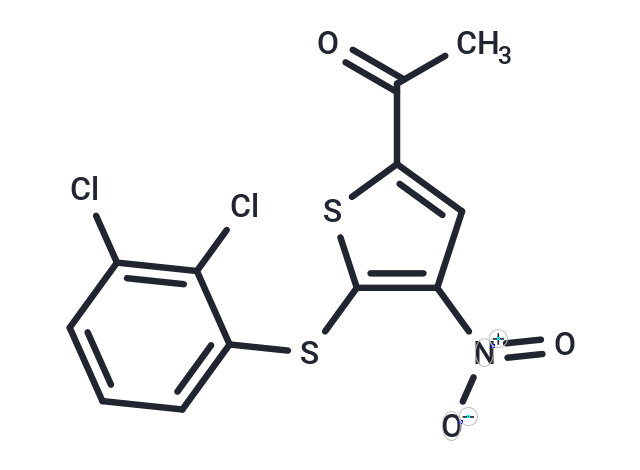Shopping Cart
- Remove All
 Your shopping cart is currently empty
Your shopping cart is currently empty

P005091 (P5091) is a selective and potent inhibitor of ubiquitin-specific protease 7 (USP7) with EC50 of 4.2 μM.

| Pack Size | Price | Availability | Quantity |
|---|---|---|---|
| 2 mg | $39 | In Stock | |
| 5 mg | $63 | In Stock | |
| 10 mg | $81 | In Stock | |
| 25 mg | $158 | In Stock | |
| 50 mg | $270 | In Stock | |
| 100 mg | $432 | In Stock | |
| 1 mL x 10 mM (in DMSO) | $68 | In Stock |
| Description | P005091 (P5091) is a selective and potent inhibitor of ubiquitin-specific protease 7 (USP7) with EC50 of 4.2 μM. |
| Targets&IC50 | USP7:4.2 μM |
| In vitro | P5091 demonstrates synergistic anti-multiple myeloma (anti-MM) activity when used in combination with Lenalidomide, the HDAC inhibitor SAHA, or Dexamethasone. In animal tumor models, P5091 is well-tolerated, inhibits tumor growth, and prolongs survival. |
| In vivo | P5091 exhibits potent, specific, and selective deubiquitinating (deubiquitinase) activity against USP7. Conversely, P5091 does not inhibit other tested DUBs or proteases from different families (EC50 >100 mM). It decreases HDM2 and HDMX levels while upregulating p53 and p21. P5091-induced cytotoxicity is partly mediated via the HDM2-p21 signaling axis, and despite the upregulation of p53 following P5091 treatment, its cytotoxic effects do not depend on p53. P5091 concentration-dependently inhibits USP7 tagged with HA-UbVME and dose-dependently inhibits USP7-mediated disassembly of ultra-high molecular weight ubiquitin chains. Moreover, P5091 inhibits the breakdown of polyK48-linked ubiquitin chains specifically by USP7 rather than USP2 or USP8. It suppresses USP7 deubiquitinase activity in MM cells without inhibiting protease activities and overcomes bone marrow stromal cell-induced MM cell growth. |
| Kinase Assay | Recombinant enzymes in 20 mM Tris-HCl (pH 8.0), 2 mM CaCl2, and 2 mM β-mercaptoethanol are incubated with dose ranges of P005091 for 30 min in a 96-well plate before the addition of Ub-PLA2 and NBD C6-HPC or Ub-EKL and EKL substrate. The liberation of a fluorescent product within the linear range of the assay is monitored using a Perkin Elmer Envision fluorescence plate reader. Vehicle (2% [v/v] DMSO) and 10 mM N-ethylmaleimide (NEM) are included as controls. |
| Animal Research | Animal Models: CB-17 SCID-mice are subcutaneously inoculated with MM.1S, ARP-1, or RPMI-8226 cells in 100 μL of serum free RPMI-1640 medium. Formulation: P005091 is dissolved in 4% NMP(N-methyl-2-Pyrrolidone), 4% Tween-80, and 92% Milli-Q water at a final concentration of 2 mg/mL. |
| Alias | P5091 |
| Molecular Weight | 348.22 |
| Formula | C12H7Cl2NO3S2 |
| Cas No. | 882257-11-6 |
| Smiles | CC(=O)c1cc(c(Sc2cccc(Cl)c2Cl)s1)[N+]([O-])=O |
| Relative Density. | 1.60 g/cm3 (Predicted) |
| Storage | Powder: -20°C for 3 years | In solvent: -80°C for 1 year | Shipping with blue ice. | |||||||||||||||||||||||||||||||||||
| Solubility Information | DMSO: 68 mg/mL (195.28 mM), Sonication is recommended. | |||||||||||||||||||||||||||||||||||
Solution Preparation Table | ||||||||||||||||||||||||||||||||||||
DMSO
| ||||||||||||||||||||||||||||||||||||

Copyright © 2015-2025 TargetMol Chemicals Inc. All Rights Reserved.